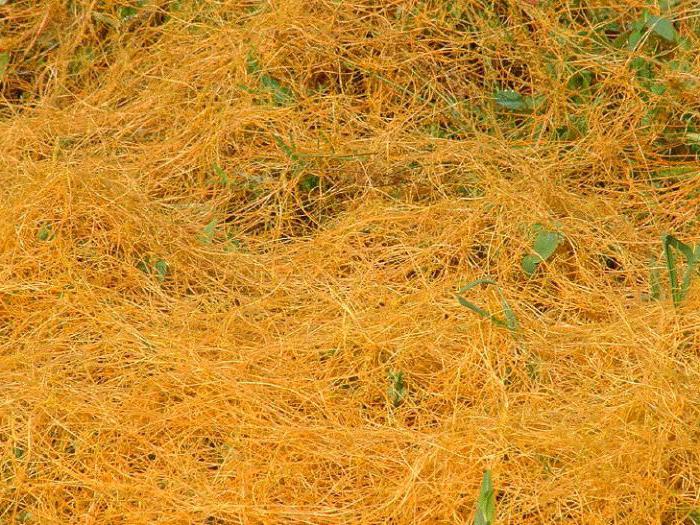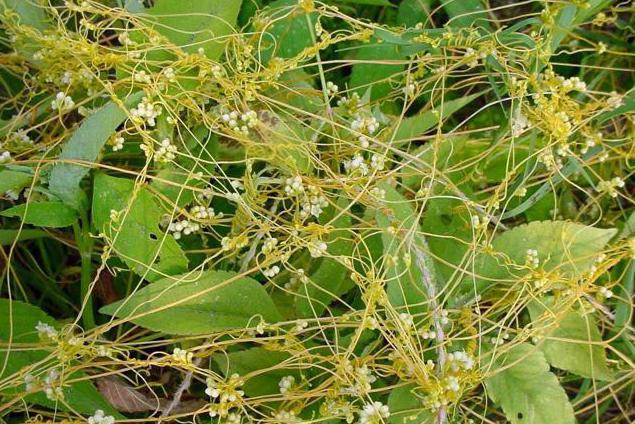Dodger - a plant-parasite probably familiar to every person; being a dangerous lianoid weed entwined with cultivated plants, it prevents the latter from developing normally, sucking out their vitality along with nutrients.
Description of the dodder
A native of Africa and tropical America, the dodger parasite plant is widely distributed throughout the world; easily adapting to new conditions and new plants, she mercilessly parasitizes on them.
Characterized by high fecundity and great vitality, the dodger comes in a thin and thick stalked form, and is found in more than 100 varieties in nature.
The most harmful plant parasite is considered to be a field, clover, hop, flaxseed. Deprived of leaves and roots, it has a body of various shades (from yellowish to reddish). The climbing parasite feeds due to the forces of the host plant, to which it is attached using peculiar suction cups (haustoria). The formation of such suction cups, which penetrate deep into the tissue of the plant and suck out nutrients from it, occurs in places of contact with the "future victim". The plant, which has become hostage to the dodder, weakens, is stunted in growth and development due to the absorption of nutrients by the weed.
Crop dodger harms
Cornfields are growing at a fast pace, weeds cover whole masses of cultivated plants, causing a decline in product quality, worsening winter hardiness and even loss of future crops.
Dodger is not capricious about the choice of the “future victim” and can settle next to any garden and garden crops; This weed does not disdain even flowers. Grass cut by hay, affected by dodder, do not dry well, lose their nutritional value, and can cause the disease of the animal, and in some cases its death.
After the parasite dodger plant attaches itself to a suitable plant, its connection with the soil is broken, and the weed is fully secured by the natural object of its choice. One weedy specimen is able to form a lesion with a diameter of up to 6 square meters. meters. The vegetative body of the dodder is characterized by high internal pressure, which allows fragments of the plant not to fade for a long time. Dodder mainly develops in the upper and middle parts of plants, enveloping them with filiform, branching, pale yellow stems.

The stalk is covered with a large number of small flowers, collected in spherical, glomerular or spike-shaped inflorescences. The fruit is a box with 2 or 4 seeds. Moreover, the latter are so similar to the seeds of cultivated plants that they are often mistaken for those. In particular, dodder seeds are similar to clover seeds, only upon careful examination can they be distinguished. Masking of dodder seeds under the sowing material of cultivated plants is the result of parasitic adaptation, which complicates the use of conventional methods of separating seeds from each other. Fodder seeds characterized by a cellular surface are mixed with magnetic powder and separated from seeds of cultivated plants using electromagnets. On their smooth surface, the powder does not linger.
Distribution of dodder
Distribution of the dodder often occurs with seeds of poorly refined cultivated plants. Also, its carriers are animals, wind, cars, water; if livestock were fed infected with dodder plants, then the latter fell into the fields with the manure of these animals. Also, dodder can be distributed with packaging or planting material. The source of infection can be weeds and wild plants infected with this parasite. Germination seeds germinate on the 5-15th day after sowing, and the first time exists at the expense of their own forces. If the dodger does not meet a suitable "breadwinner", she dies.
Dodger - plant parasite: control measures
It is very difficult to get rid of a dodder, since the effect of chemical preparations does little harm to it. This weed can only be destroyed with the plant itself. Preventive measures aimed at preventing the appearance of such a malicious natural parasite on the site are effective.

Sowing of cultivated plants is required to be carried out with seeds cleaned from dodder and in clean areas. It is necessary to test crops to determine their purity, phytopathological examination and quarantine measures. For planting, you need to choose clean areas. In irrigated areas, germination of weed seeds is stimulated by provocative spring and autumn irrigation. When a dodder appears in the crops of perennial grasses, the latter must be mowed before flowering and seeding. Especially effective is timely mowing against the field dodder, 95% of the stems of which are located close to the soil surface, which makes it easy to remove them from the field with hay at a low cut. Effective deep digging of the soil, 25-30 cm.
It is very important to prevent the appearance of dangerous weeds on the site, including a dwarf parasite plant. And the fight against them with the use of preventive preventive measures will be minimized.